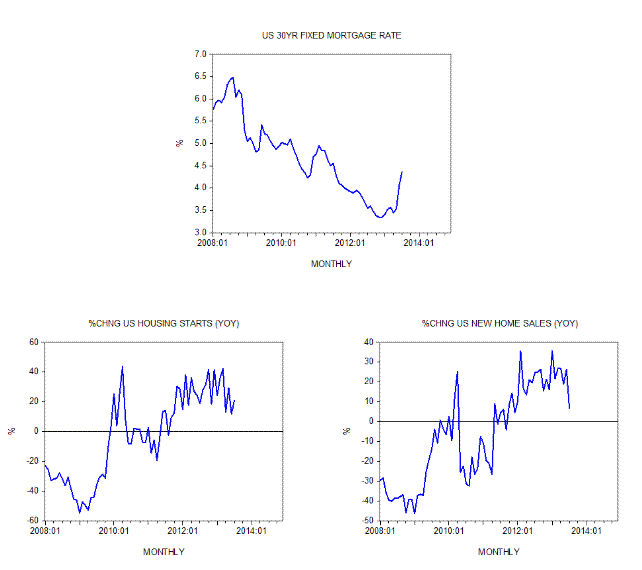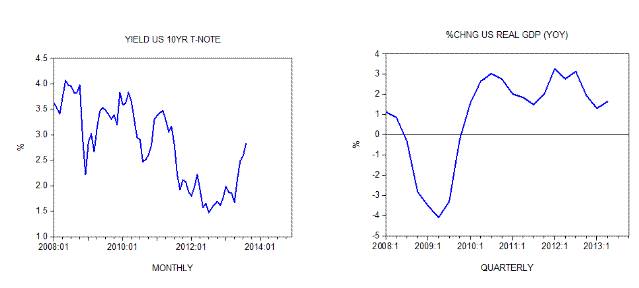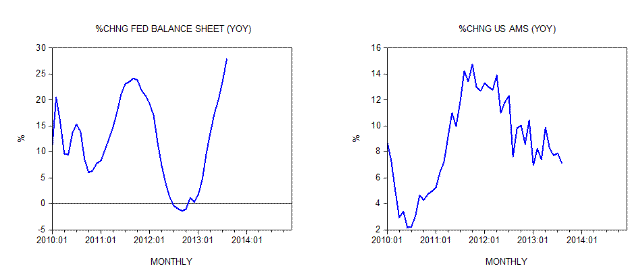Can Quantitative Easing Create Economic Growth?
Economics / Quantitative Easing Sep 22, 2013 - 01:47 PM GMTBy: Frank_Shostak
 Some commentators such as Mohamed El-Erian, the chief executive officer of Pacific Investment Management (PIMCO), are of the view that the Federal Reserve’s policy of massive asset purchases has added very little to economic growth. A study published by the Federal Reserve Bank of Kansas City explores various channels through which monetary pumping can grow the US economy. On this, the study indicates that the Fed’s purchases of mortgage backed securities (MBS) can have a strong beneficial effect. The study however suggests that with respect to the purchases of Treasury Bonds the effect on the economy is minimal.
Some commentators such as Mohamed El-Erian, the chief executive officer of Pacific Investment Management (PIMCO), are of the view that the Federal Reserve’s policy of massive asset purchases has added very little to economic growth. A study published by the Federal Reserve Bank of Kansas City explores various channels through which monetary pumping can grow the US economy. On this, the study indicates that the Fed’s purchases of mortgage backed securities (MBS) can have a strong beneficial effect. The study however suggests that with respect to the purchases of Treasury Bonds the effect on the economy is minimal.
Now, as a result of the Fed’s quantitative easing (QE) the long-term mortgage interest rate fell from 6.32% in June 2008 to 3.35% by November 2012. Consequently, the growth momentum of the housing market has had a strong response to this fall in rates with the yearly rate of growth of housing starts jumping from minus 55% in January 2009 to 42% by March 2013. The yearly rate of growth of new home sales climbed from minus 46.4% in January 2009 to 35.5% by January 2013.

Now, the yield on the 10-year Treasury Note fell from 4.07% in May 2008 to 1.615% by November 2012. After rising to 3.3% in Q1 2012 from minus 4.1% in Q2 2009, the yearly rate of growth of real GDP has been softening, closing at 1.6% by Q2 this year. From this it is concluded that it is much more effective for economic growth if the Fed were to focus on purchases of MBS’s given the strong response of the housing data to declining interest rates.

But does it all make much sense? Contrary to the popular way of thinking and the Kansas Fed study, we argue that it is erroneous to suggest that there are some channels through which monetary pumping can exert a beneficial effect on the economy.
For instance, the so-called benefits to the economy from the interest rate channel are on account of an artificial lowering of interest rates by the central bank. Such a lowering cannot set the wealth-generation process in motion; this latter effect is what real economic growth is all about. It can only lead to the misallocation of scarce capital and the weakening of the wealth generation process.
Likewise, the real balances channel (not discussed in the study but popular with the mainstream thinking), namely, an increase in the money supply relative to the increase in price inflation, will only result in an increase in the consumption un-backed by the production of real wealth; and this leads to the consumption of capital and to the weakening of the wealth generation process.
Hence various studies that supposedly show that the Fed’s quantitative easing can grow the US economy are fallacious. To suggest that monetary pumping can grow an economy implies that increases in the money supply will result in increases in the pool of real wealth.
This is however a fallacy since all that money does is serve as the medium of exchange. It enables the exchange of the produce of one specialist for the produce of another specialist and nothing more. If printing money could somehow generate wealth then world wide poverty would have been eliminated by now.
On the contrary, monetary pumping sets in motion a process of economic impoverishment by activating an exchange of something for nothing. It diverts real wealth from wealth generating activities towards non-productive activities.
We suggest that as the Fed continues with its aggressive monetary pumping there is the risk that the pool of real wealth, the key for economic growth, will become stagnant, or worse, will start declining. If this were to happen economic growth will follow suit and no monetary tricks of the Fed will be able to help.
On the contrary, the more aggressive the monetary pumping becomes the faster the pool of real wealth is going to shrink and the worse economic conditions will become.
Eventually even the government’s own data such as GDP will start displaying weakness. Remember that changes in GDP are a reflection of changes in monetary pumping: the more is pumped the greater the rate of growth of GDP.
Once, however, the pool of real wealth comes under pressure, bank lending weakens and this in turn weakens the expansion of credit out of “thin air.” Consequently, the growth momentum of money supply comes under pressure, which in turn, after a time lag, puts pressure on the growth momentum of real GDP.
The yearly rate of growth of the Fed’s balance sheet (monetary pumping) jumped to 27.6% in August from 1.8% in January. The yearly rate of growth of inflationary credit, however, fell to 2.3% in August from 14.4% in August last year.
The yearly rate of growth of our monetary measure AMS has been in a steep decline since October 2011 with the yearly rate of growth falling from 14.8% in October 2011 to 7.1% in August 2013.

Summary and conclusion
The Federal Reserve Bank of Kansas City’s study explores various channels through which monetary pumping by the Fed can grow the US economy. On this, the study indicates that as opposed to Treasury bonds purchases, the Fed’s purchases of mortgage backed securities (MBS) can have a strong beneficial effect. I maintain that it is erroneous to conclude that there are some channels through which monetary pumping can produce a beneficial effect to the economy. I also hold that monetary pumping is always bad news for the economy since it leads to the weakening of the wealth generation process and thus leads to economic impoverishment.
© 2013 Copyright Frank Shostak - All Rights Reserved Disclaimer: The above is a matter of opinion provided for general information purposes only and is not intended as investment advice. Information and analysis above are derived from sources and utilising methods believed to be reliable, but we cannot accept responsibility for any losses you may incur as a result of this analysis. Individuals should consult with their personal financial advisors.
© 2005-2022 http://www.MarketOracle.co.uk - The Market Oracle is a FREE Daily Financial Markets Analysis & Forecasting online publication.



